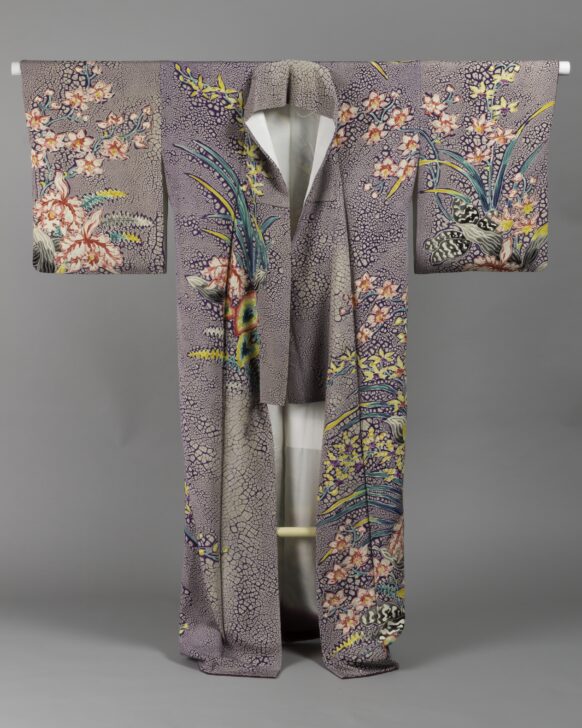Kimono
Minagawa Gekka

Description
Minagawa Gekka
Japan, 1892–1987
Kimono
Sho–wa period (1926–89)
Mid 20th century
Crepe silk with colorful wax resist design
and metallic thread embroidery
Gift of Mrs. Kazuko Miyake, 2016/2.66
Obi
Sho–wa period (1926–1989)
Mid 20th century
Plain-weave silk with roketsuzome (wax-resist dyeing)
designs of stripes and floral arabesques, and embroidery
with gold-covered threads
Gift of Howard and Patricia Yamaguchi, 2005/1.325
This kimono and obi were created by Minagawa Gekka, one of
the greatest innovators in modern textile art. Gekka’s work is
characterized by exotic motifs and complex techniques. In the kimono,
he drew a mix of fall and winter flowers in paste and then dyed the
fabric with base colors. Next, he added the crackled-ice pattern using
an age-old wax-resist technique. After the paste was washed away, he
hand painted the flowers in colorful shades: nandin on the left sleeve,
plum, chrysanthemums, thistle, amaranths, camellias and narcissus on
the front and back, and makino (Chloranthus glaber with red berries)
and more camellias on the right sleeve. For the obi he used wax-resist
to create an overall pattern of rust stripes and embroidered floral
scrolls within a limited palette to achieve the rugged feeling of folk
textiles.
The original owners of these kimono were sisters Shizuko Iwata
and Kazuko Miyake. Their mother, Shizuka Iwata, was a pioneering
female executive in early to mid-twentieth-century Tokyo who ran
a successful real estate business. Iwata ordered kimono for her five
daughters and they often wore striking identical Gekka outfits.
2021 Gallery Rotation
Subject Matter:
The floral design consists of a mix of fall and winter flowers and trees: nandin on the left sleeve, plum, chrysanthemums, thistle, amaranths, camellias and narcissus on the front and back, and makino (Chloranthus glaber with red berries) and more camellias on the right sleeve.
Chirimen refers to the unique wrinkled texture, also called crepe texture, created by a specific weaving technique. This texture is often used with traditional Japanese fabrics, often silk, wool, or synthetic fiber.
Houmongi is a semi-formal kimono that can be worn by both married and single women for social events. It is called second-class formal wear.
Houmongi is created by a patterning method called “Eba:” the pattern is dyed in such a way that it creates an unbroken design across the seams when the kimono is sewn together.
Rouketsu is hand-painted wax-resist dyeing technique, also known as batique.
In this exuberant kimono, Minagawa Gekka took great advantage of the wide, flat surface of the kimono, effectively treating it as a canvas on which to depict flowers blooming in profusion. Due to the sheer profusion of auspicious winter flowers, it is possible that this kimono was commissioned for a New Year’s celebration.
Physical Description:
Lavender and white chirimen Houmongi kimono with rouketsu dyed scale patterns and tegaki (hand-painted) white, red, pale blue and green floral patterning with metallic contour embroidery with a purple and white gradated lining? The kimono has elongated sleeves and one kamon (family crest) on the back neck.
Usage Rights:
If you are interested in using an image for a publication, please visit https://umma.umich.edu/request-image/ for more information and to fill out the online Image Rights and Reproductions Request Form.